Top speed 966 km/h Wingspan 12 m Weight 3,795 kg | Range 2,050 km Length 12 m Engine type Allison J33 | |
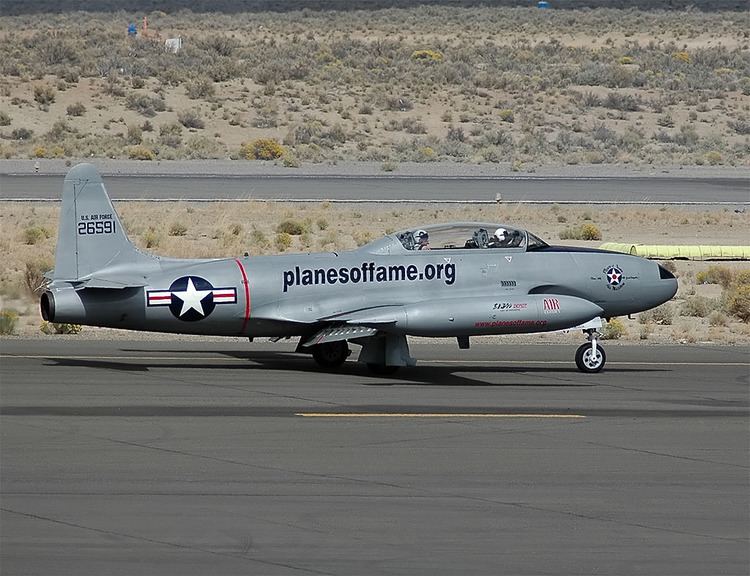 | ||
Lockheed t 33 jet trainer
The Lockheed T-33 Shooting Star (or T-Bird) is an American jet trainer aircraft. It was produced by Lockheed and made its first flight in 1948 piloted by Tony LeVier. The T-33 was developed from the Lockheed P-80/F-80 starting as TP-80C/TF-80C in development, then designated T-33A. It was used by the U.S. Navy initially as TO-2 then TV-2, and after 1962, T-33B. As of 2015, Canadian-built examples were still in-service with the Bolivian Air Force.
Contents
- Lockheed t 33 jet trainer
- Lockheed t 33 operating instructions part 1
- Design and development
- US Air Force and US Navy
- Military use by other nations
- Civilian use
- Variants
- Canada
- Other
- Operators
- Aircraft on display
- Notable accidents and incidents
- Specifications T 33A
- References
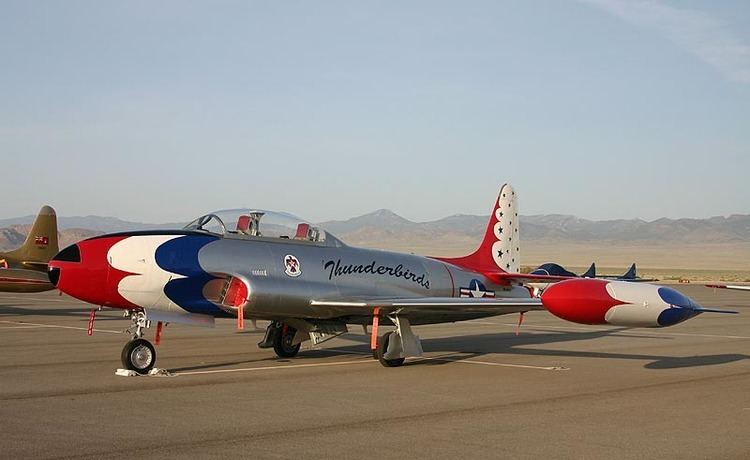
Lockheed t 33 operating instructions part 1
Design and development
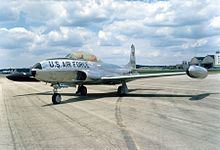
The T-33 was developed from the Lockheed P-80/F-80 by lengthening the fuselage by slightly over three feet and adding a second seat, instrumentation and flight controls. It was initially designated as a variant of the P-80/F-80, the TP-80C/TF-80C.
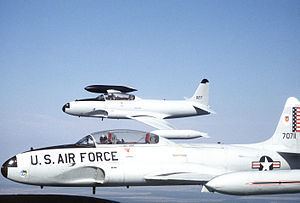
Design work for the Lockheed P-80 began in 1943 with the first flight on 8 January 1944. Following on the Bell P-59, the P-80 became the first jet fighter to enter full squadron service in the United States Army Air Forces. As more advanced jets entered service, the F-80 took on another role—training jet pilots. The two-place T-33 jet was designed for training pilots already qualified to fly propeller-driven aircraft.
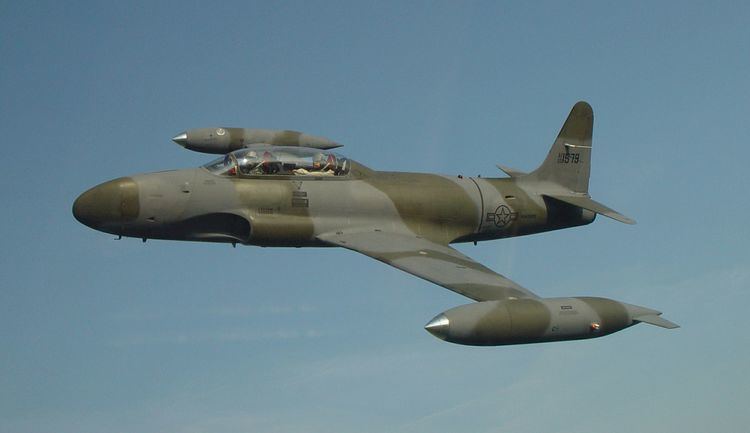
Originally designated the TF-80C, the T-33 made its first flight on 22 March 1948 with U.S. production taking place from 1948 to 1959. The US Navy used the T-33 as a land-based trainer starting in 1949. It was designated the TV-2, but was redesignated the T-33B in 1962. The Navy operated some ex-USAF P-80Cs as the TO-1, changed to the TV-1 about a year later. A carrier-capable version of the P-80/T-33 family was subsequently developed by Lockheed, eventually leading to the late 1950s to 1970s T2V-1/T-1A SeaStar. The two prototype TF-80Cs were modified as prototypes for an all-weather two-seater fighter variant which became the F-94 Starfire. A total of 6,557 Shooting Stars were produced, 5,691 by Lockheed, 210 by Kawasaki and 656 by Canadair.
U.S. Air Force and U.S. Navy
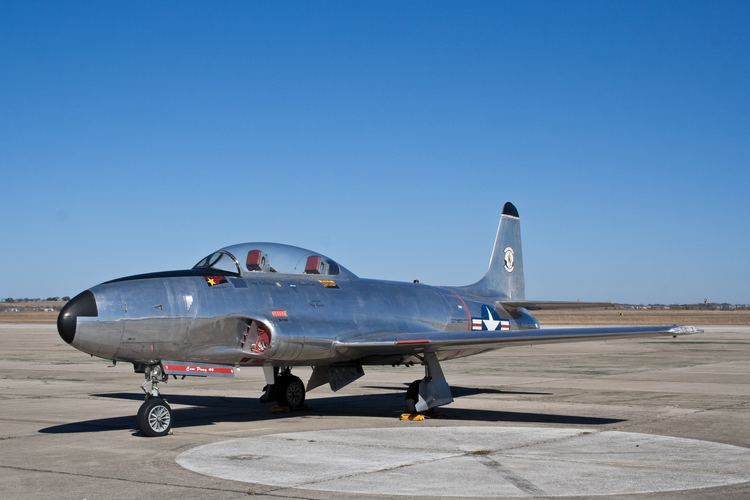
The two-place T-33 proved suitable as an advanced trainer, and it has been used for such tasks as drone director and target towing. The U.S. Air Force began phasing the T-33 out of front line pilot training duties in the Air Training Command in the early 1960s as the Cessna T-37 Tweet and Northrop T-38 Talon aircraft began replacing it under the Undergraduate Pilot Training (UPT) program. The T-33 was used to train cadets from the Air Force Academy at Peterson Field (now Peterson Air Force Base in Colorado Springs). The T-37 replaced the T-33 for Academy training in 1975. Similar replacement also occurred in the U.S. Navy with the TV-1 (also renamed T-33 in 1962) as more advanced aircraft such as the North American T-2 Buckeye and Douglas TA-4 Skyhawk II came on line. USAF and USN versions of the T-33 soldiered on into the 1970s and 1980s with USAF and USN as utility aircraft and proficiency trainers, with some of the former USN aircraft being expended as full scale aerial targets for air-to-air missile tests from naval aircraft and surface-to-air missile tests from naval vessels. Several T-33s were assigned to USAF McDonnell F-101 Voodoo, Convair F-102 Delta Dagger and Convair F-106 Delta Dart units, to include similarly equipped Air National Guard units, of the Aerospace Defense Command as proficiency trainers and practice "bogey" aircraft. Others later went to Tactical Air Command and TAC-gained Air National Guard F-106 and McDonnell-Douglas F-4 Phantom II units in a similar role until they were finally retired, with the last being an NT-33 variant retired in April 1997.
Military use by other nations
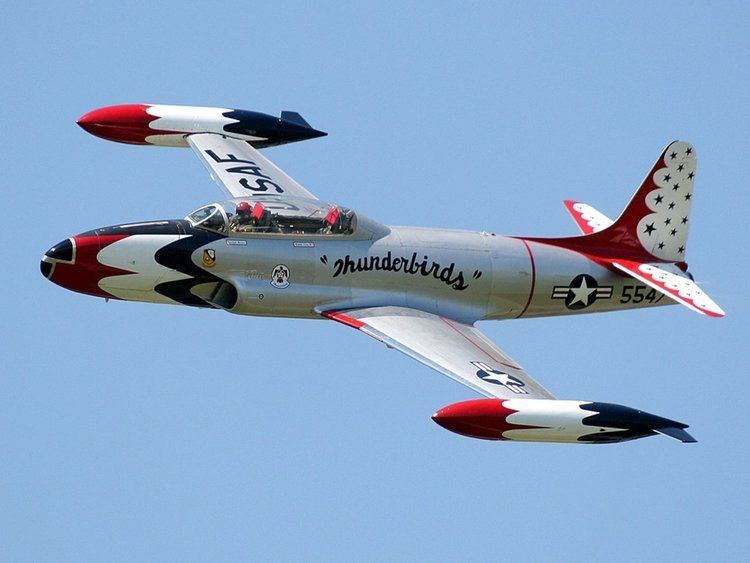
Some T-33s retained two machine guns for gunnery training, and in some countries, the T-33 was even employed as a combat aircraft: the Cuban Air Force used them during the Bay of Pigs Invasion, scoring several kills. The RT-33A version, reconnaissance aircraft produced primarily for use by foreign countries, had a camera installed in the nose and additional equipment in the rear cockpit. T-33s continued to fly as currency trainers, drone towing, combat and tactical simulation training, "hack" aircraft, electronic countermeasures and warfare training and test platforms right into the 1980s.
The T-33 has served with over 30 nations, and continues to operate as a trainer in smaller air forces. Canadair built 656 T-33s on licence for service in the RCAF—Canadian Forces as the CT-133 Silver Star while Kawasaki manufactured 210 in Japan. Other operators included Brazil, Turkey and Thailand which used the T-33 extensively.
In the 1980s, an attempt was made to modify and modernize the T-33 as the Boeing Skyfox, but a lack of orders led to the cancellation of the project. About 70% of the T-33's airframe was retained in the Skyfox, but it was powered by two Garrett AiResearch TFE731-3A turbofan engines.
In the late 1990s, 18 T-33 Mk-III and T-33 SF-SC from the Bolivian Air Force went to Canada to be modernized at Kelowna Flightcraft. New avionics were installed, and detailed inspection and renewal of the fuselage and wings were performed. Most of the aircraft returned in early 2001 and remain operational.
Civilian use
A limited number of T-33s have found their way into private hands and have been used by Boeing as a chase aircraft. In 2010, one of two T-33 Shooting Stars owned by Boeing was used as a chase aircraft during the maiden flight of the Boeing 787. Actor and pilot Michael Dorn owned a T-33. Dorn, who played the character Worf in the TV series Star Trek: The Next Generation and Star Trek: Deep Space Nine, jokingly referred to the aircraft as his 'starship'.
Variants
Canada
Other
Operators
For operators of Canadian-built aircraft refer to Canadair T-33.
Aircraft on display
Numerous T-33s have been preserved as museum and commemorative displays.
Notable accidents and incidents
While the cause is uncertain, a T-33 crashed near Allenspark, Colorado on July 27, 1965 while flying low and slow near a thunderstorm to check out newly purchased land. Both occupants, USAF Major Jay. E. Currie and USAF 1st Lt Donald Darby, were killed.
Specifications (T-33A)
Data from Lockheed Aircraft since 1913
General characteristics
Performance
Armament
